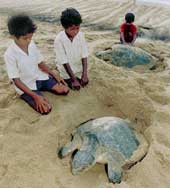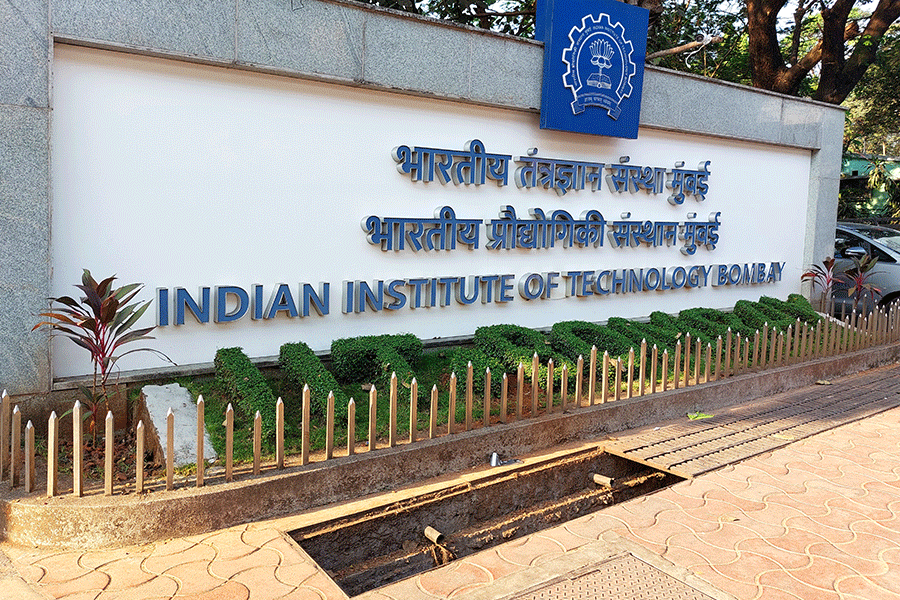|
|
| Sorry to see them go |
The animal was gasping for dear life as it tumbled out of the heaps of fish and other marine creatures captured in the trawler’s nets. Minutes after an Olive Ridley turtle got entangled in the trawler net off the mouth of the Devi river, it seemed to be destined for a suffocating death like its other hapless mates that swarm the Orissa coast between November and April. But it was a little lucky this time. The nets of the fishing vessel failed to snuff out its life as Biswajit Mohanty stepped in. Mohanty, known as the “turtle man” for his efforts to save the Olive Ridleys, flipped the near-dead animal upside down to drain out water trapped inside the body. For the next half an hour, Mohanty and his colleagues in “Operation Kachhapa” poured buckets of water as the creature wriggled, panted and tried to beat its flippers. A broad smile crossed Mohanty’s face when the animal started crawling.
But not all the turtles coming to the Orissa coast, the largest known nesting place for Olive Ridleys in the world, are that lucky. Around half a million of this species — protected under Schedule 1 of the Wildlife Protection Act of 1972 and the Convention on International Trade in Endangered Species — nest every season. Invariably, a majority die in the trawler nets, the gill nets and even propeller blades. Over the last six years, nearly 90,000 sea turtles have been killed on the Orissa coast, turning the azure blue coast into a sickly red. The trawlers have turned into virtual death machines for these turtles.
This has grave implications since it is the mature breeding adults who are being killed. This can lead to the early extinction of the population. At the current death rate, environmentalists apprehend that the Olive Ridleys will become extinct in another seven to eight years. During 2001-02, more than 14,500 turtles had been killed. In 1993-94, only 4,856 dead turtles were found on the Orissa coast. This increased to 13,575 in 1997-98 (as estimated by the Wildlife Institute of India, Dehra Dun). The point to note is that the turtles have been killed despite a plethora of laws to save them from the killing trawlers.
The Orissa Marine Fishing Regulation Act, 1982 bans trawling and mechanized fishing within five to ten kilometres (depending upon the size of the fishing boat) of the Orissa coast. Fishing is also prohibited near the mouths of the Devi river and the Rushikulya river for five months from January to May every year during the turtle nesting and breeding season. The Gahirmatha Marine Sanctuary is closed to fishing of all kinds throughout the year. Numerous other rules like coastal regulation zones are in place.
But these laws are hardly enforced. A simple mechanical grill known as turtle excluder device can easily help the turtles to escape if it is fitted to the trawler nets. Since turtles are air-breathing animals, they need to come up for breathing every hour. However, once they are trapped in the trawler nets, they are forced to remain under water for nearly three hours at a time making them drown in the process.
In December 1997, the state fisheries department made it mandatory for the trawlers to install TEDs. However, not a single trawler’s fishing licence has been cancelled since the last five years for the non-use of TEDs due to the clout of the all-too-powerful trawler owners’ lobby. In 1996, there was a workshop at Paradip for the use of TED. This year, another such workshop was held by the fisheries department and the United Nations Development Programme at Paradip to teach the trawler fishermen how to use TEDs. Although no-fishing zones have been declared at the mouths of the Devi and Rushikulya rivers, hundreds of trawlers from Orissa, Andhra Pradesh and West Bengal can still be found illegally fishing within one to two kms of the shore.
Official apathy is in evidence everywhere. While the Orissa Marine Fishing Regulation Rules of 1983 permits a maximum of 1,000 mechanized fishing vessels from all the eight fishing bases of the Orissa sea coast, this year an apathetic fisheries department issued licences to 6,000 mechanized boats. The fisheries department also does not have a modern patrol vessel though the Centre had given them one crore rupees four years ago for acquiring such a vessel. Another one crore was given by the Indian Oil Corporation to the Orissa government in 1999 for turtle protection. During the last three years, not a rupee of the IOC grant has been spent, whereas the money could have been used to acquire a couple of fast patrol boats.
“Enforcement of the fishing regulation in the no-fishing zone is the key to turtle protection,” says Mohanty, who, as project coordinator of Operation Kachhapa, has been crying himself hoarse to ban all fishing activities within five kms of the shore. More than 90 per cent of the turtles congregate in this area. Effective patrolling of the three congregation areas — mouths of the Devi river and Rushikulya river and the Nasi islands in Gahirmatha — in December and January would just be enough to save these turtles. But the rising death toll of the turtles every year shows that the officials are just not bothered about the safety and preservation of this migratory species.
While trawlers are the main purveyors of death for the turtles, of late mono-filament gill nets have taken a heavy toll on their lives. On February 17 this year, 205 egg-bearing female turtles were found dead in a multi-filament gill net at offshore waters of Ekakulanasi within the Gahirmatha Marine Sanctuary. Six days later, 92 turtles, most of them female, were found dead in a mono-filament gill net near Nasi Islands at the mouth of the Dhamra river. One gill net can kill hundreds of turtles if it is cast in the turtle congregation areas.
A few weeks back, a high-powered committee meeting of the state government chaired by the agriculture production commissioner, S.C. Hota, decided that from December 8, the vessels of the coast guard, the forest department and the fisheries department would work in tandem to patrol the waters near three strategic points — Nasi islands, Devi river mouth and Rushikulya river mouth. The coast guard has launched Operation Oliver to allow the turtles a safe passage to their nesting grounds. It would also be empowered under OMFRA to seize all fishing trawlers in the prohibited zone.
But the committee’s record is not too illustrious. On January 30 this year, it met and decided to enforce the no-fishing regulations when half of the turtle season was over, and nearly 10,000 turtles had died. Predictably, the committee’s resolutions for this year have failed to enthuse environmentalists. “The recommendations are as ritualistic as the meetings at the state secretariat,” scoffs a turtle expert.
The sea turtles have innumerable natural enemies with only one hatchling of every 1,000 eggs reaching childhood. Dogs and vultures are also natural predators of the turtles. Now, the high turtle mortality, owing to natural reasons and the trawler menace, has started affecting the annual congregations. During the 2001-02 turtle season, the Olive Ridleys deserted the Orissa coast; the much-awaited congregation did not happen at the Gahirmatha coast. Despite sea patrolling by the forest department officials at Gahirmatha, an estimated 3,000 turtles died in the marine sanctuary.
With the government shirking responsibility, there is no alternative but to depend on the non-governmental initiative, Operation Kachhapa, to spread awareness about the plight of the turtles. The initiative by the Wildlife Protection Society of India and the Wildlife Society of Orissa is directed by Belinda Wright and coordinated by Biswajit Mohanty. As part of its programme, a sea turtle interpretation centre has been opened at Bhubaneswar which also showcases the plight of the turtles on the Orissa coast.
A recent wildlife film made by Shekhar Dattatri, The Last Stand of the Olive Ridleys, details how the survival of the Olive Ridleys are becoming increasingly uncertain. But the turtles are still coming to the Orissa coast. Mohanty and his co-workers might have saved the hapless turtle for the moment. But the death machines masquerading as fishing trawlers have the potential to suffocate the rest to a cold and horrific death very soon.











